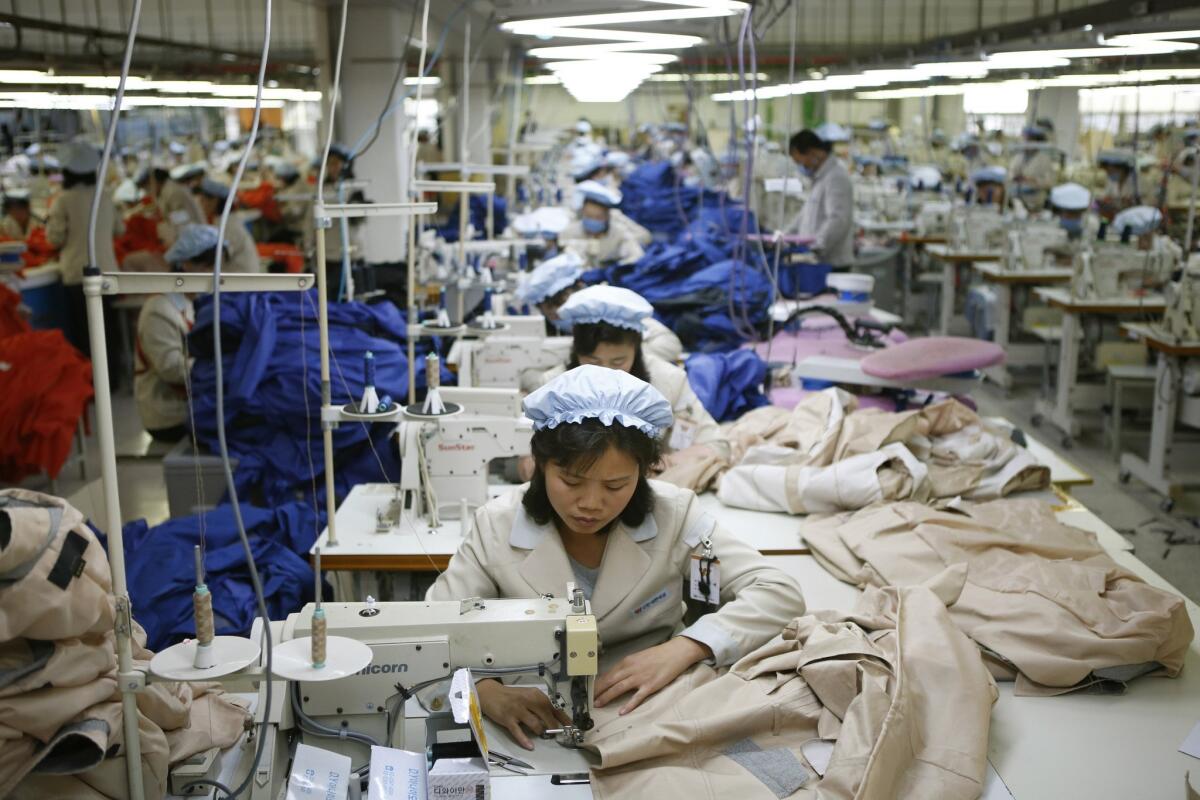Investing in resource-rich North Korea seems like a good idea — but businesses find there’s a catch

- Share via
Reporting from Seoul — When an industrial park jointly run by the two Koreas was abruptly shuttered by South Korea’s government three years ago, the South Korean factory owners were so caught off guard that one of them left behind his wedding ring. Another was unable to retrieve a photo of his late mother.
A third business owner, Yoo Chang-geun, still has a closet full of clothes and $17 million worth of factory equipment at the Kaesong Industrial Complex, six miles north of the heavily fortified demilitarized zone marking the border between the Koreas. Yoo, 62, chief executive of an auto parts and information technology equipment manufacturer, is one of about 120 South Korean business owners who ran factories at Kaesong at the time of the February 2016 closure.
When the joint venture began in 2002, Kaesong was aimed at showcasing North Korea’s economic potential. Marrying South Korea’s technology and business acumen with North Korea’s low-cost labor, it was also viewed as a diplomatic tool to ease the isolated nation into connections with the outside world and pave the way for additional investments.
But since its closure in retaliation for North Korean nuclear testing, it has served more as a cautionary tale about the potential pitfalls of investing in North Korea. The industrial park’s fate remains suspended in geopolitical limbo, any hope of resumption blocked by the international sanctions imposed on North Korea for its nuclear tests.
As business owners have waited for Kaesong to reopen, some of their companies have gone bankrupt. Others have relocated to Vietnam. One shoe manufacturer, who put his business on hold, died last year.
“It’s been anticipation, then disappointment, anticipation, then disappointment,” Yoo said. “We’re hanging onto the tail end of our hope.”
Many of the executives thought that when President Trump and North Korea’s Kim Jong Un met for a second time in Hanoi last month, there would be at least a partial easing of sanctions, clearing the way for their businesses to access the disrepair, if not resume operations, at the site.
After all, Trump himself has repeatedly touted North Korea’s economic prospects.
“If you think of it, you have on one side Russia and China and on the other you have South Korea, and you’re surrounded by water. And among the most beautiful shorelines in the world,” Trump said, while announcing he and Kim couldn’t reach a deal and that sanctions would remain in place. “I think it’s going to be an absolute economic power.”
The no-deal summit was a letdown not only for the factory owners at Kaesong, but also for other potential investors in South Korea and elsewhere eyeing opportunities to make inroads into North Korea.
One of Asia’s last all-but-untapped markets, North Korea has antiquated railways and highways and an out-of-date power grid in critical need of updating and expansion.
In recent years, the North Korean government has put out a largely unheeded call for foreign investment, promising handsome returns.
RELATED: North and South Korea break ground on linked railway despite sanctions »
Singapore-based American investor Jim Rogers, famed for co-founding the Quantum Fund with George Soros, has said in numerous media interviews that he wants to invest in North Korea. He said in a South Korean television interview in January that he believes North Korea will be “the most exciting country in the world for the next decade or two” for investors.
In December, Rogers became an outside director of Ananti, a South Korean resort developer that has a golf course and hot springs at North Korea’s Mt. Kumgang — another economic project between the Koreas that was closed and put on indefinite hold after North Korean soldiers fatally shot a South Korean tourist in 2008.
“Most South Korean corporations were making preparations internally in anticipation of sanctions being relaxed,” said Lim Hyung-sub, an attorney for the Seoul firm Lee & Ko specializing in potential economic collaborations with North Korea. “A lot of people expected at least a small deal.”
Lim said anyone looking to do business in North Korea needs to be wary of the fact that the country’s legal system is not up to par regarding property rights or investment guarantees, and that even if sanctions are lifted, significant reforms will be needed.
“My concern is there will be such a rush and enthusiasm, that people won’t take sanctions seriously enough,” said Michael Hay, a British French attorney who maintained a legal office in Pyongyang for 12 years advising businesses before suspending operations in 2016 due to sanctions.
Hay said he saw the business environment ebb and flow with the news headlines over the decade he worked in North Korea, and he remains upbeat about the country’s potential.
“Having seen and experienced everything during that time, this logjam on this international sanctions issue, it can’t last forever,” he said. “I’m confident some things are going to change.”
Yoo was among the first to set up shop at Kaesong in 2004. “I was drawing on a blank canvas, walking Robert Frost’s ‘road less traveled,’” he recalled.
He spent three years training the workforce provided by North Korea, mostly citizens of nearby Kaesong, many of whom had to learn to type. They were quick learners, he said. Eventually, 400 North Korean employees worked for him, providing IT services to other companies at Kaesong that were manufacturing auto parts and working in research and development.
The political risk came with financial benefits — the North Korean workers’ wages started at $50 a month, about one-tenth the minimum wage in South Korea in 2004, to be increased by not more than 5% annually, according to Yoo. By the end, he was paying his workers $180 a month.
At the peak, about one-fifth of the revenue for his company, SJ Tech, came from the North Korea business, he said.
The North Korean government periodically held the industrial park hostage to retaliate for perceived provocations, cutting off access in 2009, and pulling its workers for six months in 2013 after joint military exercises between the U.S. and South Korea. After each hiccup, the Koreas would find a way to mend relations, and operations resumed.
Then in early 2016, North Korea detonated what it claimed was a hydrogen bomb, marking its fourth nuclear test, and launched a rocket using the same technology as for ballistic missiles.
During the Lunar New Year holiday in February, while most of the South Korean factory owners and managers were away celebrating with their families, the South Korean government abruptly announced it was shutting down Kaesong. It was the first time South Korea had pulled the plug.
The $560 million North Korea had earned from its laborers at Kaesong, paid to Pyongyang rather than to the workers directly, had in effect subsidized its nuclear program, South Korean officials reasoned in statements at the time.
Yoo said he lost $4 million and the Chinese company that distributed his goods went bankrupt. Buyers who had relied on him for parts lost faith. His entire company, which he started in 1997 with five employees, teetered on the brink of insolvency, he said.
Even so, Yoo said he still held out hope that Kaesong could be the first success story for investments in North Korea’s economy. He still wakes up some mornings thinking he’s headed across the DMZ to North Korea for work.
“If you start thinking negatively, there’s no end to it,” he said. “If U.S.-North Korea relations improve, it could be a new dawn.”
More to Read
Sign up for Essential California
The most important California stories and recommendations in your inbox every morning.
You may occasionally receive promotional content from the Los Angeles Times.











